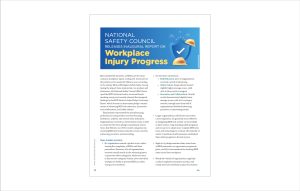National Safety Council Releases Inaugural Report on Workplace Injury Progress
Musculoskeletal disorders, or MSDs, are the most common workplace injury, costing U.S. businesses in the private sector nearly $17 billion a year, according to the Liberty Mutual Workplace Safety Index. Recognizing the impact these injuries have on workers and businesses, the National Safety Council (NSC) developed the MSD Solutions Index, an annual benchmarking survey, and recently released the inaugural findings in the MSD Solutions Index Pledge Community Report, which focuses on three main pledge commitments of advancing MSD risk reduction, innovation and collaboration, and safety culture.
Respondents represented the manufacturing, professional, transportation and warehousing, healthcare, utilities, and several other industries. Organizations received an overall index result, as well as results for the three pledge commitment subsections, that fell into one of five results categories representing MSD prevention maturity: novice, reactive, advancing, proactive, and innovating.
Major insights included:
- No organization earned a perfect score, underscoring the complexity of MSDs and their prevention. However, 85% of organizations received overall results in the advancing (39%) or proactive (46%) categories, while 15% were in the reactive category. Further, 54% rated their workplace’s ability to prevent MSDs as either very good or excellent.
- For the three subsections:
• Risk Reduction: 44% of organizations received a result of advancing.
• Safety Culture: Respondents showed slightly higher average scores, with 42% in the proactive category.
• Innovation and Collaboration: Overall results demonstrated slightly lower average scores, with 31% scoring as reactive, though more than half of organizations exhibited advancing, proactive, or innovating results. - Larger organizations, which have more than 1,000 employees, are generally more effective at mitigating MSD risk, as they are more likely to have mature, long-standing safety programs and resources to adopt more complex MSD solutions and technology. In contrast, the majority of small- to medium-sized businesses established their safety program in the last 5 years.
- Eight in 10 pledge members have some form of MSD prevention or ergonomics program in place, and 65% have methods for tracking MSD rates across their workplace.
- Nearly two-thirds of organizations regularly conduct employee perception surveys, and nearly 90% have methods in place for workers to share suggestions for safety improvements. Notably, the MSD Solutions Index showed that when it comes to safety decisions related to workstation design, employees’ physical work environment, and workflow, frontline workers are regularly consulted on these issues, which leads to stronger safety cultures.
- Nearly 85% of organizations reported that psychosocial risk factors contribute to MSDs in their workplace. These risk factors include things like mental health, fatigue, lack of tracking, and lack of personnel and proper equipment or tools.
- More than 80% are currently using technology in their workplace to prevent MSDs, and just as many are effective at ensuring these best practices are broadcast widely across their organizations.
In addition, the report outlined several steps and actions organizations should take, including:
- Engaging senior leadership, designating an MSD solutions champion to represent the workforce, and creating and empowering an MSD solutions team to collaborate throughout an organization;
- Collecting and responding to employee feedback regularly and measuring the progress of an MSD program and safety culture, and tracking the impact, solutions effectiveness, return on investment, and year-over-year change;
- Identifying risk factors with involvement from frontline workers and implementing appropriate changes; and
- Ensuring MSD solutions are equitable for all employees.
To learn more about these efforts, visit www.nsc.org/msd.

